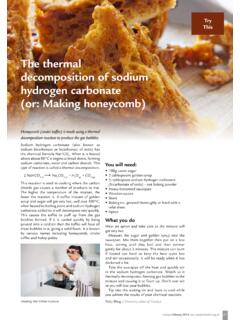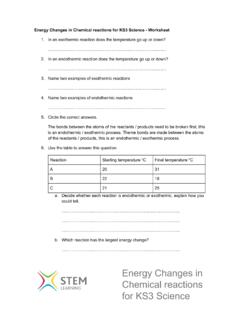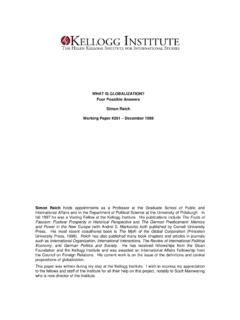Transcription of Approaches Diagnostic questions - STEM
1 TEACHER NOTES Developed by the University of York Science Education Group and the Salters Institute. 1 This document may have been edited. Download the original from University of York Science Education Group. Distributed under a Creative Commons Attribution-NonCommercial (CC BY-NC) license. Best Evidence Science Teaching Approaches Diagnostic questions There is, as Black and Wiliam noted in Inside the Black Box, a body of firm evidence that effective use of formative assessment can have a powerful effect on student learning. But what makes assessment truly formative? And what is the difference between formative assessment and a Diagnostic question?
2 Different types of assessment Assessment provides information about students learning. This evidence can be used for different purposes. In summative assessment, the information is used to make a judgement about learning, for example to give students a grade or to put them in a rank order. It can also be used to give evidence about the quality or impact of teaching, and can be linked to school accountability measures. However, summative assessment does not usually provide more information about students knowledge and understanding than a grade, mark or level. When the evidence provided by an assessment is used to help a teacher work out what a student thinks, this is Diagnostic assessment.
3 For example, it could provide evidence of what ideas a student can recall from previous teaching, or whether they hold particular misunderstandings that could be barriers to progression. Assessment is formative if it provides feedback to the learner and to the teacher which is then used to help decide what to do next. Both summative and Diagnostic assessments can be used in formative ways. The key to this is using the evidence gained to contribute directly to the learning process by informing what should happen in response. Hence, it is not the format of an assessment but the use to which it is put that makes it formative.
4 There is a body of firm evidence that formative assessment is an essential feature of classroom work and that development of it can raise standards. We know of no other way of raising standards for which such a strong prima facie case can be made on the basis of evidence of such large learning gains. Paul Black and Dylan Wiliam, Inside the Black Box (1998) It was only when I discovered that feedback was most powerful when it is from the student to the teacher that I started to understand it better. When teachers feedback from students as to what students know, what they understand, where they make errors, when they have misconceptions then teaching and learning can be synchronised and powerful.
5 John Hattie, Visible Learning (2008) TEACHER NOTES Developed by the University of York Science Education Group and the Salters Institute. 2 This document may have been edited. Download the original from University of York Science Education Group. Distributed under a Creative Commons Attribution-NonCommercial (CC BY-NC) license. Diagnostic questions Often, a learning objective will require students to know or understand a scientific idea, but we cannot gauge whether or not a student knows or understands anything unless we collect evidence. Assessments provide evidence of learning, usually because a student can or cannot select or provide an answer that indicates they understand the scientific idea that was the subject of the learning objective.
6 A Diagnostic question goes further, providing greater insight into what students are thinking. This can include an indication of how confident they are in the answer they have chosen, or their ability to provide a scientific explanation for their answer. A good Diagnostic question can also provide evidence of common misunderstandings (and problematic conceptions derived from everyday life) that are held by the student, which could prevent progression in developing the required level of scientific understanding. Embedding Diagnostic questions into teaching Diagnostic questions can be used formatively, and most effectively, in lessons when the questions are short and focussed on a single idea.
7 Multiple-choice formats are a useful way of making Diagnostic questions that are quick to complete, highly focussed, and very powerful. A range of useful formats is presented and discussed in the appendix of this article. Multiple-choice questions can be used at the start of a teaching episode to check prior knowledge, part way through to check progress, or at the end to check whether students have grasped the idea sufficiently to move on. They can be displayed at the front of class and students asked to indicate their support for each answer using a voting system. Alternatively, students can complete the question individually, or in pairs or small groups to encourage discussion and metacognition.
8 Revealing misunderstandings In the Diagnostic question shown on the right, option D is the best explanation of melting. It indicates understanding of the particle model of matter and how it helps us explain changes of state. The other options are not so obviously wrong that they can be dismissed easily if they were, the question would lack Diagnostic power. Options B and C reveal common misunderstandings (that particles are embedded in the bulk substance, and ascribing properties of the bulk substance to the particles from which it is made, respectively). Option A is an explanation that applies ideas about particles, but lacks complete understanding.
9 Sharing high quality questions may be the most significant thing we can do to improve the quality of student learning. Dylan Wiliam, Embedded Formative Assessment (2011) TEACHER NOTES Developed by the University of York Science Education Group and the Salters Institute. 3 This document may have been edited. Download the original from University of York Science Education Group. Distributed under a Creative Commons Attribution-NonCommercial (CC BY-NC) license. The Diagnostic questions in the Best Evidence Science Teaching (BEST) collection have been developed from research evidence on common and everyday misunderstandings that can prevent progression towards scientific understanding, and come complete with teacher notes that describe the underlying research.
10 There are a number of readily available books that describe misunderstandings commonly held by students (for example: Driver, Guesne and Tiberghien, 1985; Driver et al., 1994; Allen, 2014), in addition to a wealth of papers published in peer-reviewed journals. How to respond what next? Diagnostic questions are a key means of identifying students difficulties in science, and it is important that the evidence they provide about students thinking is used formatively to adapt subsequent teaching. But deciding exactly what to do next in response to the information provided by a Diagnostic question can be difficult.










